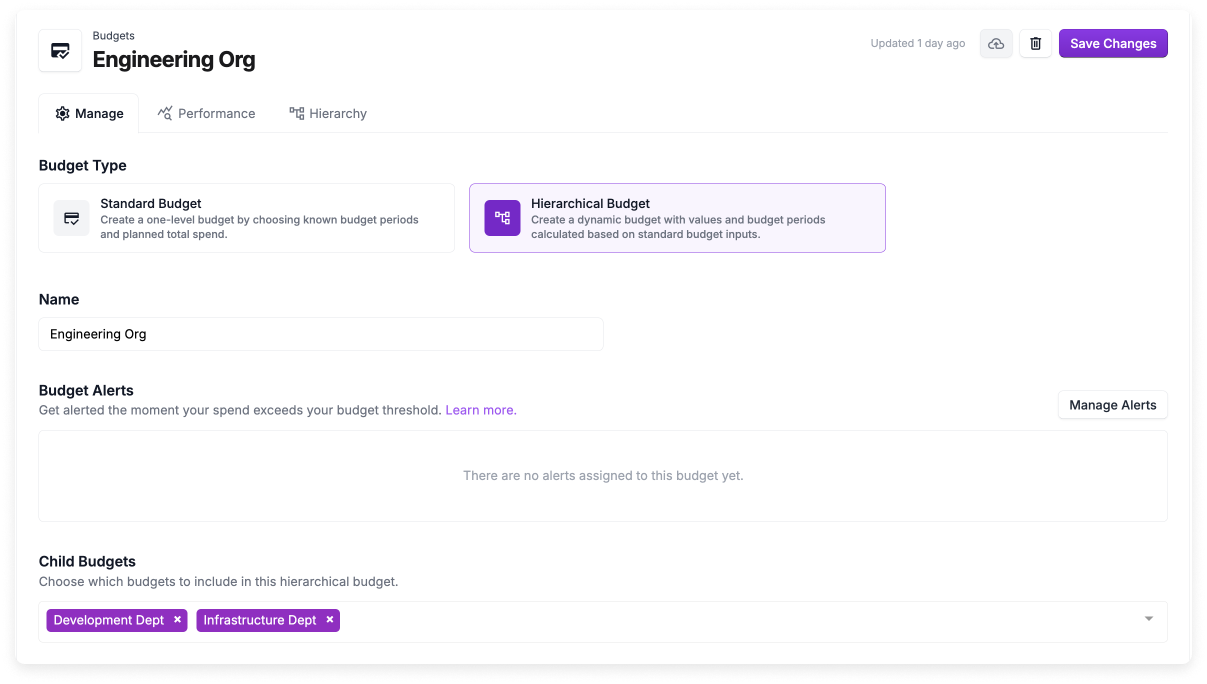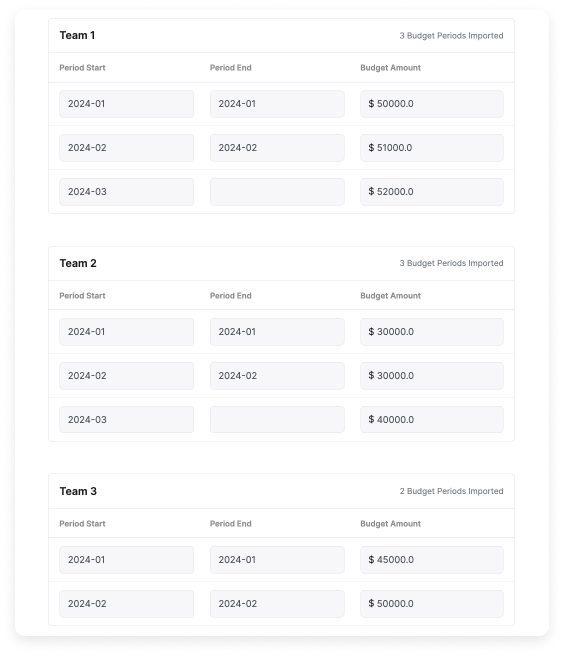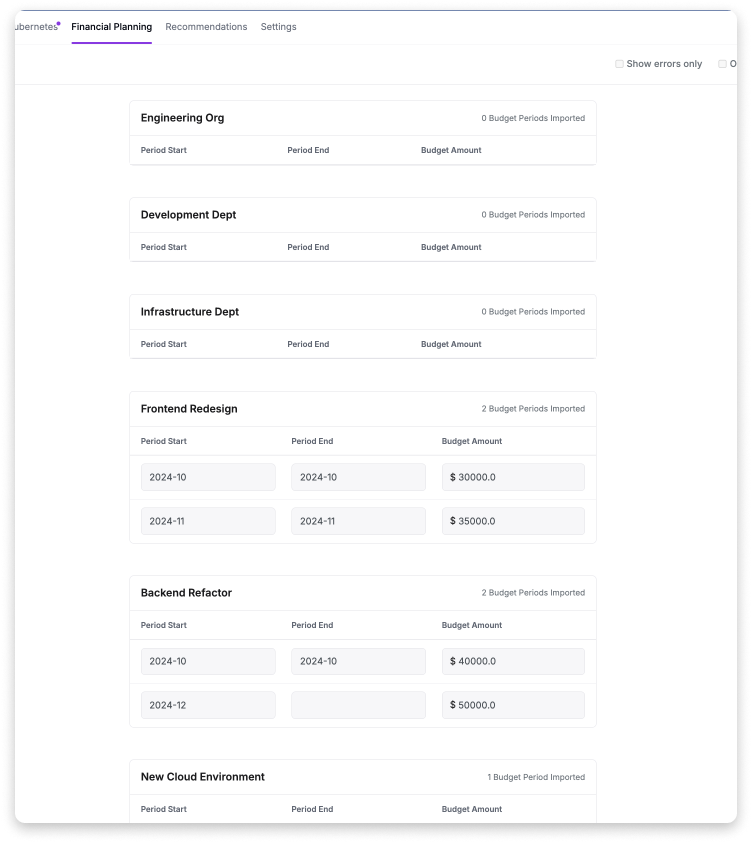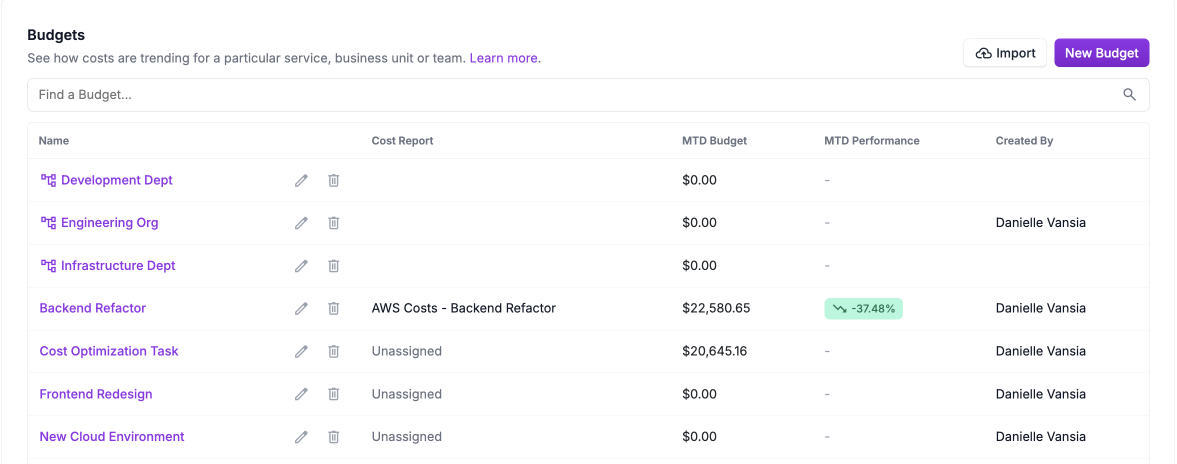Budget Types
In Vantage, you can create either Standard or Hierarchical budgets:Standard Budget
This type of budget has one level that may have multiple time periods associated with it. For example, you could use this type of budget to track costs for a single department or project.Hierarchical Budget
This type of budget is composed of multiple child budgets that roll up to a parent budget.- For example, an application team can create individual budgets for AWS, Azure, and Databricks usage and then create a single budget for their application that combines all three of these children budgets. If the AWS budget changes, the parent application budget is automatically updated.
- Similarly, the organization’s FinOps team can consolidate multiple AWS budgets from various teams into a single, comprehensive parent budget to measure all AWS spend.
- You can create a budget hierarchy with a maximum of 10 levels.
- Each parent budget aggregates the budget periods of its child budgets. If a child budget has no allocated budget for a specific period, that period contributes nothing to the parent’s total.
- A Hierarchical Budget can be converted into a single-level Standard Budget. This action breaks the connection between the parent and child budgets in the hierarchy.
- A child budget can be used only once within a given hierarchy.
- Example: You create a hierarchy with a parent budget for the “Marketing Organization” and child budgets for “Social Media Campaigns,” “Event Marketing,” and “Content Creation.” The child budget for “Social Media Campaigns” cannot also appear under “Event Marketing” within the same hierarchy to avoid duplication in budget calculations.
- A child budget can belong to multiple separate hierarchies.
- Example: Suppose your organization is structured both by departments and projects. A child budget for “Mobile App Redesign” might belong to the “Product Development” department’s hierarchy, while also appearing in a completely separate hierarchy for cross-functional “Q1 Strategic Initiatives.” This allows you to manage and report on budgets across different organizational contexts.
Budgets Screen
To access the main Budgets screen in the console:- From the top navigation, click Financial Planning.
- On the left navigation, select Budgets.
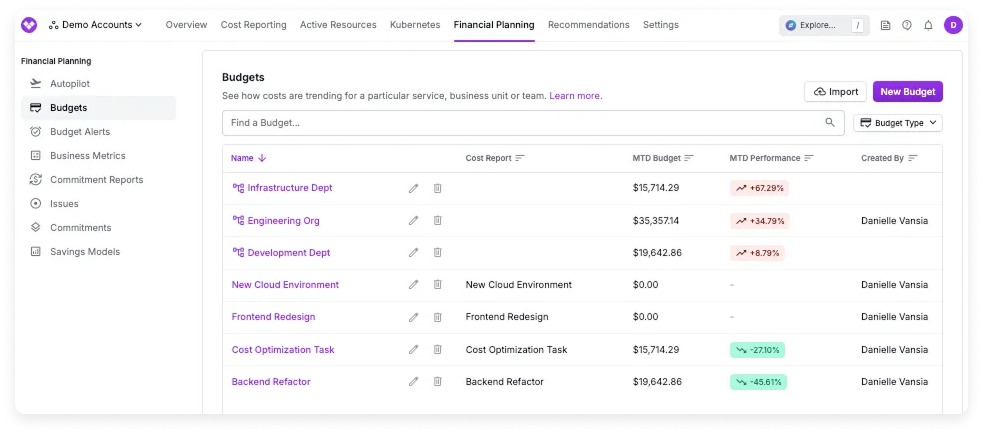
- Each budget is displayed with a link to the budget’s configuration screen.
- Any hierarchical budgets with corresponding child budgets include the hierarchy icon to the left of the budget’s name. In the example above, Infrastructure Dept, Engineering Org, and Development Dept are all considered hierarchical budgets with corresponding child budgets.
- The Cost Report column indicates the corresponding attached Cost Report. Only terminal child budgets can be associated with a Cost Report.
-
MTD Budget represents the prorated budget allocation for the month based on the number of days elapsed.
- For hierarchical budgets, this value is the sum of the MTD Budgets of all child budgets.
- For example, if the monthly budget for Cost Optimization Task is $40,000 and today is February 11, then 11 days have elapsed out of 28. The MTD Budget is calculated as:
- The MTD Performance column shows the percentage of actual spend relative to the MTD Budget, helping indicate whether spending is over or under budget for the month to date.
Create a Budget - UI Method
The below instructions describe how to manually create a budget in the UI. You can also upload a CSV file to create a budget. See the section below for details.
1
Begin on the main Budgets screen. From the top right of the screen, click New Budget.
2
Enter a budget Name and click Create Budget.
3
The budget details page is displayed. For Budget Type, select either Standard Budget or Hierarchical Budget. The options displayed differ for either budget type.
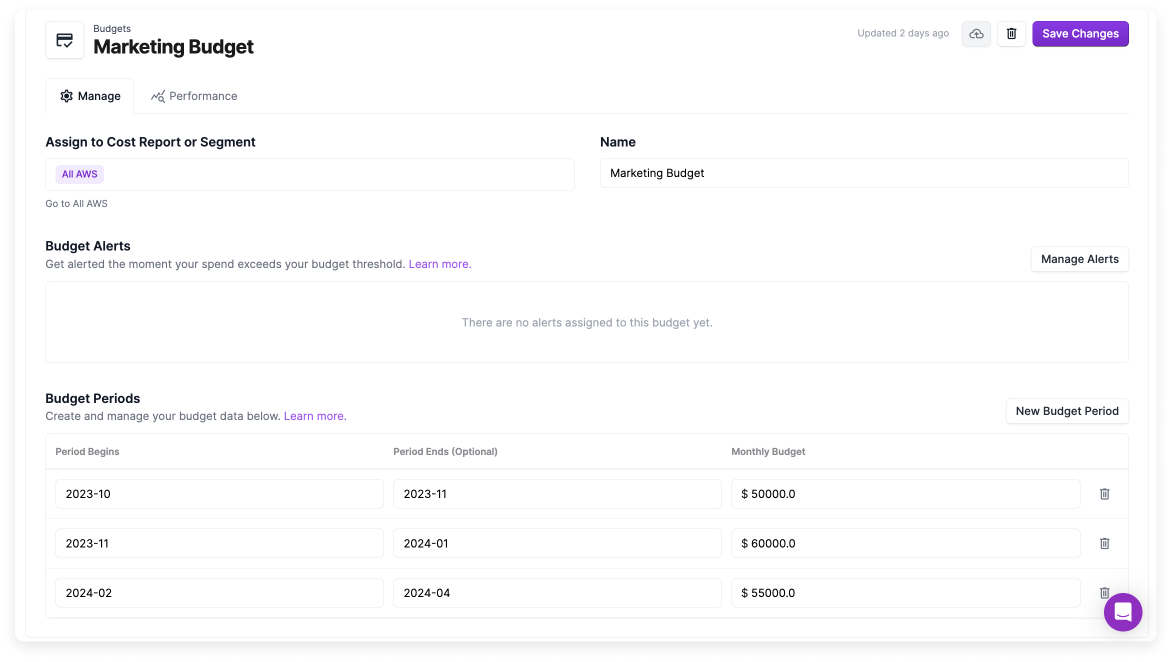
- Standard Budget
- Hierarchical Budget
- Under Assign to Cost Report or Segment, select the report you want the budget to be displayed on. See the section below for details.
- For Budget Alerts, you can optionally assign alerts once your budget is created. Any existing alerts will also be listed here. See the section below for more details.
- For Budget Periods, click New Budget Period. Standard Budgets can have multiple budget periods, one for each month, with a specific amount for each period:
- Enter a start date in YYYY-MM format (e.g., 2024-03).
- Enter an optional period end date.
- Enter a total monthly budget amount in dollars.
- Click New Budget Period to add additional budget periods.
Click to view example image
Click to view example image

4
At the top right, click Save Changes.
Create a Budget - CSV Import Method
If you have existing budgets in spreadsheets or another tool, you can import them all at once by uploading a CSV file.Expected Format
Budget import files must adhere to the following requirements:- The file must be in CSV format.
- The header row of the CSV must start with a unique string or identifier (e.g.,
Budget Name).- The remaining values in the header row must be the budget period start date in
YYYY-MMformat (e.g.,2023-02for February 2023).
- The remaining values in the header row must be the budget period start date in
- Each additional row in the CSV must start with the name of the budget. Corresponding values must be expressed as decimals (e.g.,
25000.00) for every month with an associated budget. If there is no budget for a month, the value can be blank. - If the budget is a Hierarchical Budget, include the
Parent Budgetcolumn.
Standard Budget Format
The below example of three Standard Budgets shows a readable view, CSV file format, the budget import screen, and the final budget in Vantage. Team 3 does not have a budget for 2024-03, and therefore, no budget period is added for Team 3 during that timeframe. On the import, the period start and end date are set based on the column headers.- Standard Budget
- CSV File
- Import Screen
- Imported Budgets
| Budget Name | 2024-01 | 2024-02 | 2024-03 |
|---|---|---|---|
| Team 1 | 50000 | 51000 | 52000 |
| Team 2 | 30000 | 30000 | 40000 |
| Team 3 | 45000 | 50000 |
Hierarchical Budget Format
The below example of a Hierarchical Budget shows a readable view, CSV file format, the budget import screen, and the final budget in Vantage. Note that the parent budgets—Engineering Org, Development Dept, and Infrastructure Dept—do not have any amounts listed since these budgets are composed of the corresponding child budgets—Frontend Redesign, Backend Refactor, New Cloud Environment, and Cost Optimization Task. The associated next-level parent is listed in theParent Budget column.
- Hierarchical Budget
- CSV File
- Import Screen
- Imported Budgets
| Budget Name | Parent Budget | 2024-10 | 2024-11 | 2024-12 |
|---|---|---|---|---|
| Engineering Org | ||||
| Development Dept | Engineering Org | |||
| Infrastructure Dept | Engineering Org | |||
| Frontend Redesign | Development Dept | 30000 | 35000 | |
| Backend Refactor | Development Dept | 40000 | 50000 | |
| New Cloud Environment | Infrastructure Dept | 60000 | ||
| Cost Optimization Task | Infrastructure Dept | 30000 | 40000 |
Import Budget
Once your CSV file is prepared, follow the steps below to import any type of budget.1
From the top navigation, click Financial Planning.
2
On the left navigation, select Budgets.
3
From the top right of the screen, click Import. The Import Budget Data modal is displayed.
4
Click Choose File and select a CSV file.
5
Click Upload. The Review Imported Errors screen is displayed. If no errors are present, click Confirm > OK.
Fix Import Errors
If a formatting error is found in your imported CSV file, the import wizard indicates where the error occurred. To fix the error, correct the issue in your source CSV and re-upload the file. In the below example, an error occurred because the CSV file contained duplicate values in the header row.- Error Screen
- Source CSV File
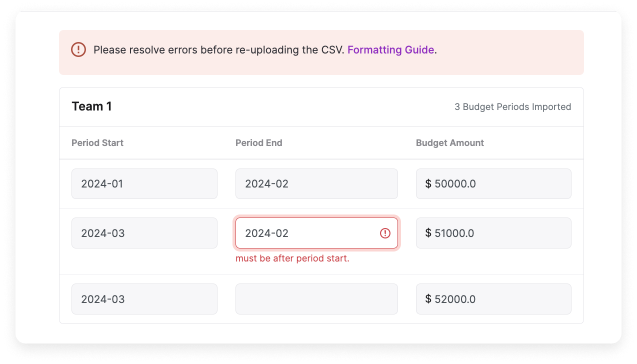
- There should be no additional blank columns in the CSV file.
- Ensure that each budget name is unique.
- Confirm that the budget name does not already exist in Vantage. If it does, you will be prompted to overwrite the existing budget with the newly uploaded one.
- If you want to overwrite an existing budget, select the Overwrite budget periods option at the top and confirm. Any budgets with the same name will be replaced with the data from your new file.
Click to view example image
Click to view example image
- Ensure the dates in the header row are in the correct format (i.e.,
YYYY-MM). - Values cannot include other characters and can be in decimal format (e.g.,
56000.00or56000, not$56,000.00). - For Hierarchical Budgets:
- Ensure that parent budgets do not have any amounts listed in any of the budget periods columns. Budget amounts should be provided only for terminal child budgets.
- Any budget listed in the
Parent Budgetcolumn should already be present in Vantage or defined within your current CSV file. - A child budget can be used only once within a given hierarchy.
View Budget Performance and Hierarchy
For any budget type, you can view both the Performance and Hierarchy tabs to get an understanding of how the budget is performing and see any corresponding child budgets (if relevant).Budget Performance
Select the Performance tab to see each budget period with a month-to-date performance of how the budget performed or is forecasted to perform. The details on this screen will vary depending on whether you are viewing a parent budget or a terminal child budget.Parent Budget Performance
Each child budget is listed in the table along with its Budgeted Spend (total budgeted spend for that month) for a given month and the Actual Spend (either the amount spent in a previous month or the current plus forecasted spend for the current month). If the Actual Spend exceeds the Budgeted Spend, the value is highlighted red. In the example below, Infrastructure Dept is a parent budget with the following two child budgets.| Budget Name | 2024-12 | 2025-01 | 2025-02 |
|---|---|---|---|
| New Cloud Environment | $60,000 | ||
| Cost Optimization Task | $30,000 | $40,000 |
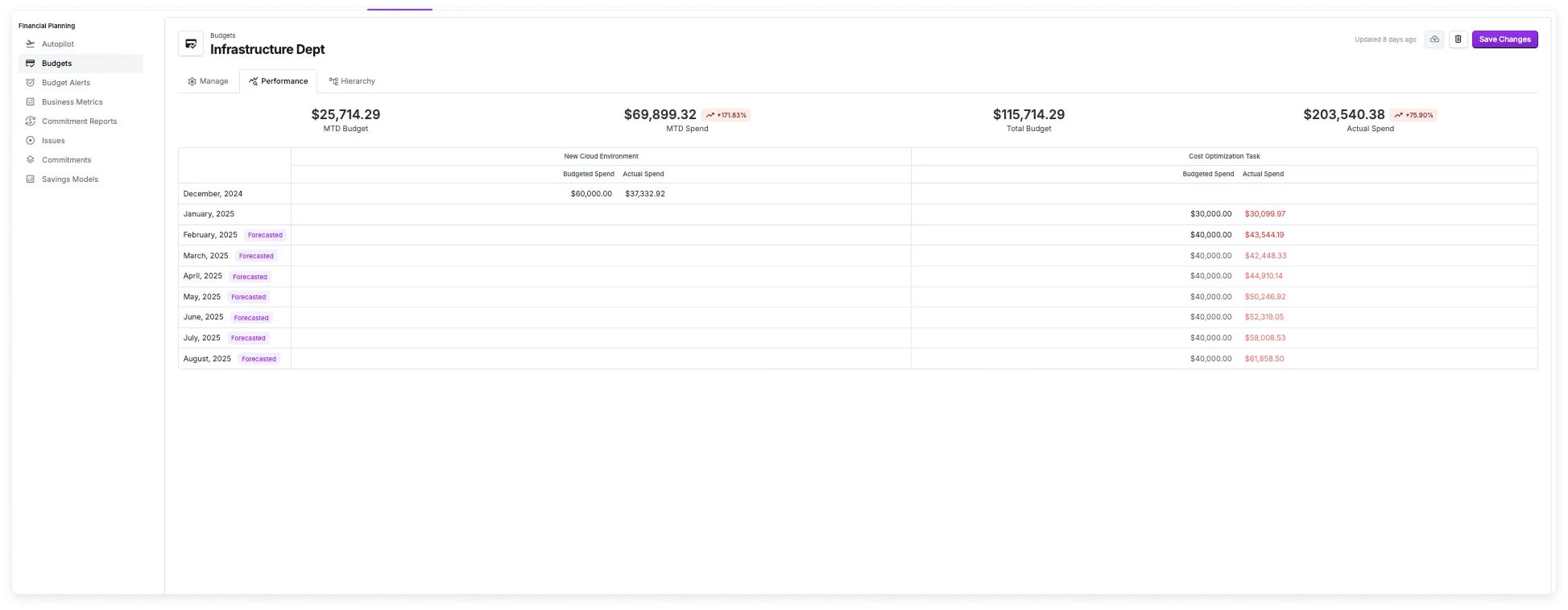
- MTD Budget: The total budget accrued for the month up to the current date. For the Infrastructure Department, only $40,000 was budgeted for the month of February (the New Cloud Environment Task has no February budget). For this example, it is February 18th, so then the MTD Budget is calculated as:
- MTD Spend: This is the total amount spent for the month so far across all listed budgets.
- Total Budget: This is the total amount that’s been budgeted to date, prorated for the current month. In the example above, this is calculated as follows:
- Actual Spend: The total amount spent to date across both child budgets, including all expenditures—even for months when no budget was allocated. In this example, it covers all spend from December 1 to February 18 for both the New Cloud Environment and Cost Optimization Task budgets.
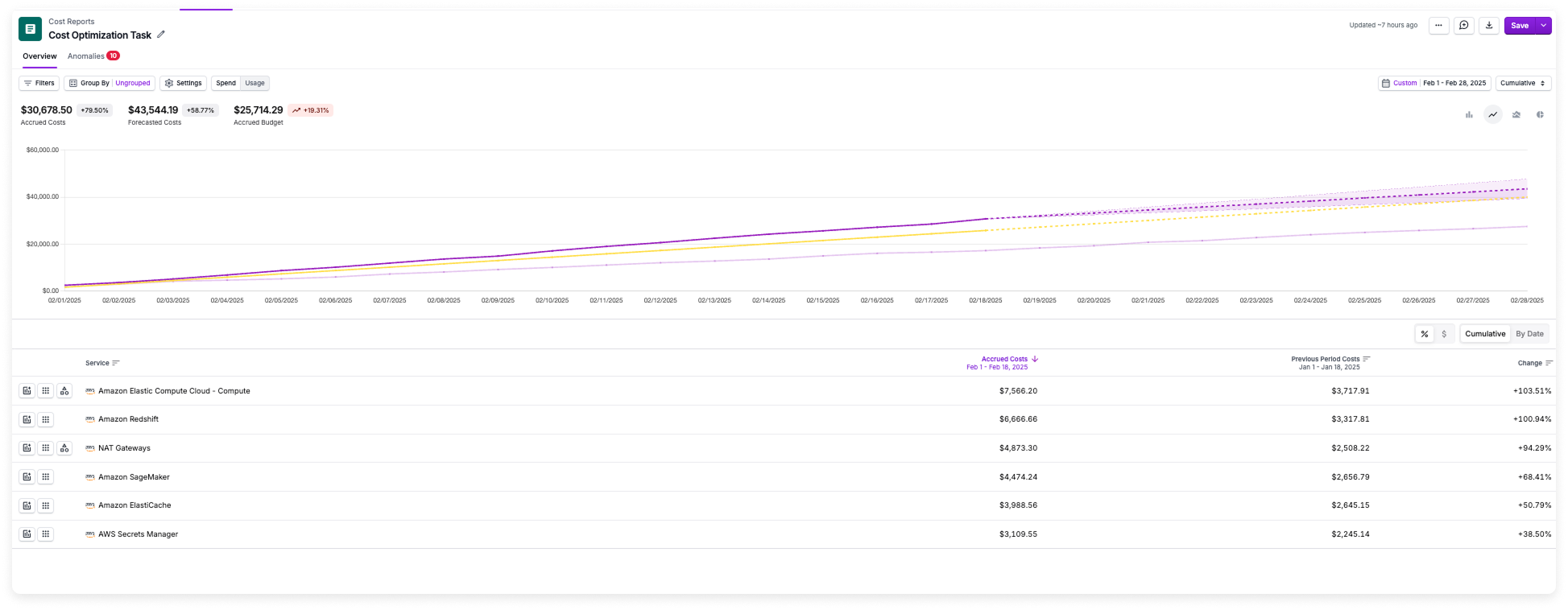
Child Budget Performance
On a budget with no associated children budgets, the Performance tab displays the following information.
- The monthly budgeted amount is shown alongside the percentage by which actual spend is over or under budget. In the example above, the January budget was $30,000, while actual spend totaled $30,099.97—exceeding the budget by 0.33%. For ongoing months, the actual spend percentage is calculated using forecasted costs.
- The header provides the following information:
- Accrued Costs: Total accrued costs for the current month.
- Performance (MTD): The percentage by which the accrued budget is over or under the total accrued costs for the month. In this example, the accrued costs for the month are $30,678.50, while the accrued budget is $25,714.29 (calculated as , since it is February 18). The performance is 19.31% over budget, calculated as:
- Accrued Costs (YTD): Total accrued costs from January 1 to the current date.
- Performance (YTD): Calculated just like Performance (MTD) but takes into account all accrued costs from January 1 to present.
Budget Hierarchy
On the Hierarchy tab, a graph is displayed that provides a time-series view of Actual Spend and Total Budget. The details provided on this screen are the same for parent and child budgets.- On the header, the same values are displayed that are on the Performance tab.
- Hover over a point on the graph to see a point-in-time view of the cumulative budget, actual spend, and the difference between the two values.
- In the table, if the budget is a parent budget in the hierarchy, any immediate child budgets are listed along with their related performance. You can click the link for any listed child budget to move to the Hierarchy screen for that particular child budget.
- The following information is provided in the table below the chart:
- MTD Budget: The prorated budget accrued for the month.
- MTD Spend: The total amount spent for the month.
- MTD Performance: The percentage by which the accrued budget is over or under the total accrued costs for the month.
- Total Budget: This is the total amount that’s been budgeted to date, prorated for the current month.
- Actual Spend: The total amount spent to date—even for months when no budget was allocated.
- Performance: The percent the Actual Spend is over or under the Total Budget.
View Budgets on Cost Reports
Once a budget is assigned to a Cost Report, a budget report with month-to-date performance is displayed at the top of the Cost Report. The budget reflects amortized costs throughout the month, indicating whether the spending is above or below the budget month to date.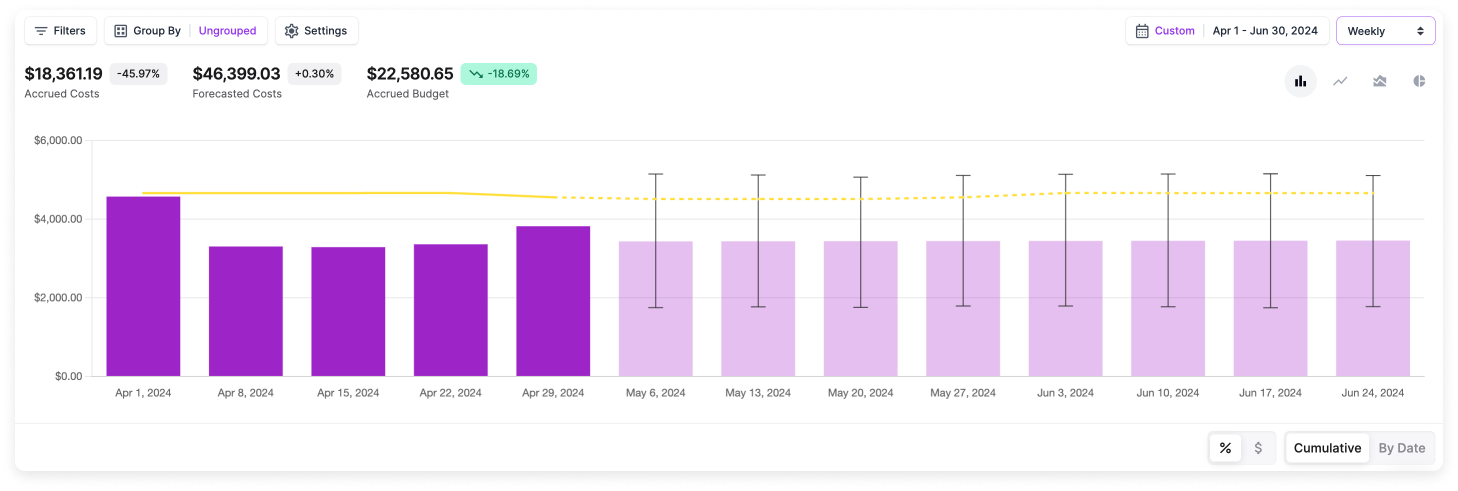
If you select the Weekly view, you may see the budget line dip for the first and last week of the month. This is because budgets are metered per day.
Budget Alerts
Budget alerts are automated alerts based on configurable budget thresholds. Create a budget alert for any of your existing budgets to notify you when a percentage of a budget is exceeded for a designated period. You can configure alerts to notify Vantage users via email, Slack, Microsoft Teams, or Jira. Periods can be set before or after a certain number of days into the month (e.g., “10 days from the start of the month”). You can create budget alerts for any type of budget—Standard or Hierarchical. For Hierarchical Budgets, the costs associated with the child budgets are aggregated at the parent budget level to determine if a budget alert should be set off.If you want to send alerts to Slack, Microsoft Teams, or Jira, see the Slack, Microsoft Teams, or Jira integration documentation. Once you’ve set up an integration, follow the steps below to set up a budget alert.
1
From the top navigation, click Financial Planning.
2
On the left navigation, select Budget Alerts.
3
At the top, click Configure Alert.
4
The New Budget Alert modal is displayed. Configure the following parameters:
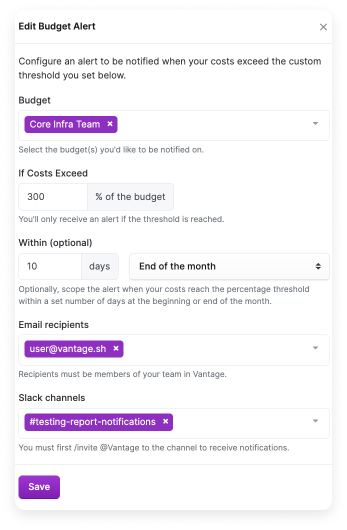
- For Budget, select the budget for which the alert applies.
- For If Costs Exceed, select a percentage threshold (e.g., 85% of the budget). You’ll receive an alert only if the threshold is reached.
- Optionally, enter a period of observation within the month (e.g., “10 days from the start of the month” or “5 days before the end of the month”).
- For Email recipients, select recipients, who are members of your team in Vantage, you want to receive the alert.
- Optionally, select any Slack channels, Microsoft Teams channels, or Jira projects you want to receive the alert.
Click to view example image
Click to view example image

5
Click Save. Budget alerts will look similar to the below image.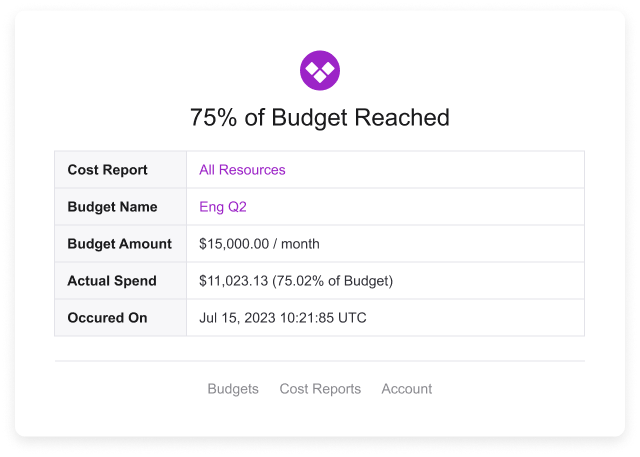

Budget Alert Limitations
At this time, only dynamic, percentage-based thresholds are supported. Budget alerts can be configured only to send alerts based on actual, not forecasted costs.A single cost increase will not typically trigger a budget alert. If you are interested in this feature, see the Cost Anomaly Alerts documentation.
